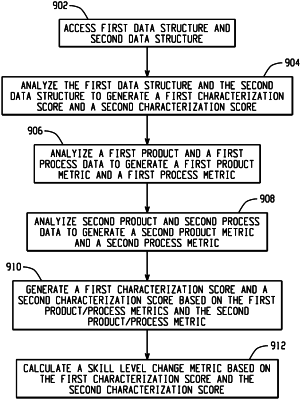| CPC G09B 7/02 (2013.01) [G06F 16/24578 (2019.01); G09B 19/00 (2013.01)] | 20 Claims |

|
1. A computer implemented method for assessing progression of skill development using a scenario-based assessment over a period of time, comprising:
accessing a first data structure associated with a first product prepared by a student in response to a scenario based assessment prompt, wherein the first data structure includes the first product generated by the student extracted from the response to the scenario based assessment prompt and first process data extracted from analysis of keystroke analytics associated with the student in generating the first product, wherein the keystroke analytics comprises data associated with which keys are pressed by the student and the relative timing of the keys pressed;
analyzing the first data structure to generate a first characterization score, wherein the first characterization score is based on both the first product and the first process data, wherein the first characterization score is generated by:
analyzing the first product to generate a first product metric, wherein the first product metric is generated by capturing first product features from the first product associated with the response to the scenario-based assessment;
analyzing the first process data to generate a first process metric, wherein the first process metric is generated by capturing first process traits associated with the keystroke analytics from the first process data associated with the process of generating the first product;
generating the first characterization score based on the first product metric and the first process metric;
later in the scenario based assessment, accessing a second data structure associated with a second product prepared by the student, the second data structure including the second product generated by the student and second process data associated with second keystroke data analytics associated with the student in generating the second product, wherein the second keystroke analytics comprises data associated with which keys are pressed by the student and the relative timing of the keys pressed;
analyzing the second data structure to generate a second characterization score, wherein the second characterization score is based on both the second product and the second process data associated with the second keystroke analytics; and
calculating a skill level change metric based on the first characterization score and the second characterization score indicating a change in ability level of the student over a course of the scenario based assessment, wherein the skill level change metric is stored in a computer-readable medium, transmitted over a network, and displayed on a graphical user interface.
|